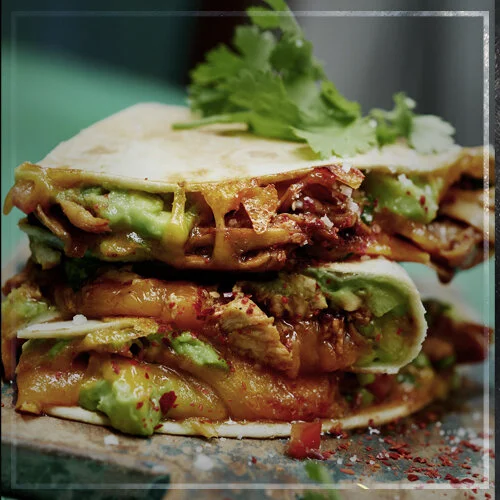The Chinese Temple Kitchen - Chengdu Wenshuyuan
Photos & Text: Jan-Peter Westermann
Recipes: Martina Hasse
Foodstyling: Jan-Peter Westermann
„Dear Passenger, please do not leave any belongings in my car. Thank you and have a nice day“. The tinny and hollow sound came from my cab’s speakers. Not saying anything, the driver turned around and looked at me, expectant, hoping that I would hand over the right amount of money. “Tse tse” I mumbled while getting out of the car. This was the end of our short conversation and I wasn’t really sure if I had reached the destination I was looking for. Because neither could I read the piece of paper, which I had handed the driver at the beginning of our trip, nor did I recognize any points of orientation in the dark, looming lights of sunrise. The street signs were poorly lit, if at all.
Luckily the pagoda-style rooftops behind the wall on the other side of the street looked much different from the rest of Chengdu. Almost ten million people live in this gigantic metropolis, far from easy to navigate.
I collect my luggage, cross the wide, busy street and moments later I dive into a completely different world. I have arrived in Wenshayuan, one of the most important active monasteries in Sezchuan.
This place of calmness and tranquility immediately casts a spell over me. Resting on black pillars, the access balconies decorate the entire monastery, connect different wings and open up space towards ever changing, magical courtyards. The dark red, contrasted with hints of black, gives the decoration a mystic feeling. But not only the colors, also the characters on the wall and various wooden sprouted windows have their effect on me. The variety of open and closed perspectives immediately test your sense of orientation. Where am I?
Especially in the early morning hours time appears to stand still.
The noise of the awakening city is blocked through the walls and my eyes follow the yellow dresses, a group of monks, awestruck. At 6AM starts the morning mess which they seem to walk to. I follow them.
Even in the last row I can smell the intense aromas of scented candles and the melodic chants echo through the inner rooms of the Buddhist temple. It’s forbidden to participate, let alone to take pictures. But Liang, the administration manager of the monastery, reads my hopeful expressions correctly and gives consent with a quick nod.
After one hour of Buddhist liturgy I flow towards the dinning hall together with a group of 150 novices. The staring eyes of lion heads on the wall give me an eerie feeling. On the other side of the hall I finally come across an empty space on one of the raw wooden banks. The monks dine in a separate space which is exclusively reserved for them and personnel of the house. The warm kitchen steam in the filled halls immediately fogs my camera lense. Almost no one takes notice of me. Dining is part of Buddhist teaching and leads to your inner self.
A collective prayer blesses the meal and the room, illuminated with yellow neon lights, turns silent. Just before the experienced kitchen staff fills my plate with a scoop of cauliflower mushroom, transferred by a wooden spoon. The warm transparent slime of one of China’s more popular healing mushrooms is decorated with a few goji berries. But when I try the first spoon I am almost surprised by the sweet, almost fruity flavor.
A completely different world seemingly opens up for me and I do not hold any doubts that this morning soup will do wonders for my inner “Chi”.
Sweet soup of silver ear with Chinese wolfberries
15 g dried silver ear mushrooms (3-5 pieces, no more), alternatively fresh ruffle hen
1 small handful of Chinese wolf berries
200 g white candy sugar
Zubereitung
Die getrockneten Pilze und die Wolfsbeeren warm abbrausen und vorsichtig säubern. Beides getrennt mit kochendem Wasser überbrühen und zugedeckt acht bis zwölf Stunden stehen lassen. Die Pilze brauchen einen großen Topf voll Wasser, denn sie quellen stark (am besten in einem gut die Wärme haltenden Tontopf oder Römertopf). Dann die Pilze in ein Sieb abgießen und abtropfen lassen. Harte, dunkelgelbe und verschmutzte Stellen entfernen und die Pilze nochmals abbrausen. Nun die Pilze in einem großen Topf mit frischem Wasser aufkochen und anschließend bei geringer Temperatur weich köcheln. Die abgetropften Wolfsbeeren dazugeben, weiterkochen und nach 20 Minuten den Zucker beifügen. Sobald sich dieser aufgelöst hat, ist die Suppe fertig. Die Pilze sind dann ganz weich und die Suppe wie mit Stärke gebunden. Als vitaminschonende Alternative kann man die Pilze auch 1 Stunde über Dampf garen.
Vegetarian "chicken soup" with Judasears
Ingredients
100 g Judas ears, fresh or dried (approx. 15 pieces)
300 g tofu skin
1 tbsp soya starch flour
50 g wheat flour
1 tsp sea salt
1/2 I vegetarian broth
1 pinch of black pepper
Nutritional yeast for seasoning
1 tsp sugar
1-2 tbsp cold-pressed rapeseed oil
1/2 tbsp roasted sesame oil
Preparation
Pour plenty of boiling water over dried mushrooms and soak for 1/2 to 1 hour, then drain. The mushrooms swell up strongly. Clean the mushrooms, remove all hard, crusty and dirty spots. Soak the tofu skin in hot water for 30 minutes, then rinse and steam in a steamer for 10 minutes until soft. Meanwhile mix soy flour, wheat flour and 1 pinch of salt in a bowl with so much water that you get a soft, but not liquid mush. Spread out a tofu skin on the worktop, apply a thin layer of flour porridge on top, then place another layer of tofu skin on top, apply another layer of porridge and continue until all the tofu skin has been used up. Roll it up into a roll, wrap it firmly in a clean cloth and wrap it tightly with a non-staining string and tie it tightly. Steam the tofu sausage for 20 minutes over a large amount of bubbling water. Then take it out and let it cool down. This is the "vegetarian chicken meat". Wrap the tofu roll from the cloth and cut into 3 mm thin slices (see photo). Place these decoratively together with the Judas ears in a soup bowl, carefully pour in the hot broth and add all the spices and rapeseed oil. Place the bowl in the steamer over boiling water for 5-7 minutes. Finally drizzle with sesame oil and serve hot.































